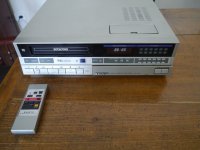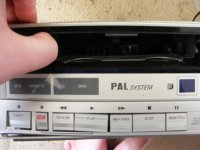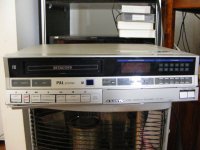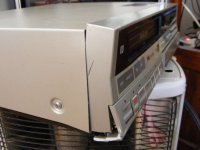Oh yes, those still abound. 🙂 Haven't seen has many as there used to be, but that may be seasonal or regional. The George Foreman grill used to be all over the thrift shops.but the undisputed king of discarded electronics is still the ink jet printer.
I like thrift shop LPs, you can find some fun stuff. I've started collecting corporate promotional LPs. For Example: Al Hirt does one for United Airlines, or a collection of songs about rain for a tire company, Buick promotional giveaways, Magnavox, etc. Seemed to be popular in the 50s-60s.
Some inkjet printers had nice external power supplies which simply were a 40va 10-0-10 transformer in a box. Very useful to power preamps or even small power amps.
Nigel - yes Betacam was a really good format and you've likely seen 1000s of hours that was shot on it. It certainly did come as a stand-alone deck which is mostly what I used. The were large and expensive. I remember putting a portable Betacam SP deck in my car once and thinking "this thing costs more than my car." Betcam and Betcam SP were the standard workhorse throughout the 1990s. I had seen them before, but couldn't afford to use them.
JVC had the MII (M two) format the some people used and loved. At one point JVC came out with digital VHS and I saw it at the NAB show in Vegas. Looked great! it was a. pro format. Didn't last long, as I recall.
For years now we record onto hard drives in ProRes format. With ProRes you to to choose the quality you want, higher quality just means larger files. ProRes is a "gently compressed" format.
Thanks for confirming. Paul Stewart of JVC UK ( in the past ) talked about the JVC pro machine with me the other day. Paul might be the unknown person who caused VHS to take off Worldwide. It was very much the UK that helped and gave BRC the green light to bypass JVC UK. Sony could have had that business. Paul also was involved in the Mobile Fidelity LP's and JAS11 amplifier. His favourite thing I suspect was little JVC metal mini speakers much the same as Visonic Davids. Much like Control 1's and Teac LSX8's ( very good ). Paul mostly designed the Acoustic Energy AE-1 for Phil Jones.
I've been doing pro video for 30 years.
Just the person I need to ask. What adhesive tape do you use for joining tape and leader together? I'm packing newish VHS tape into old Betamax cartridges starting next week and would like an adhesive tape better than the stuff that is packaged in those little splicer kits that you get off ebay for $20-$30. After I back up the contents of the Betamax tapes of course to my 9x6TB hdd array and then eventually onto LTO-5 and LTO-6 tape.
The tapes will be used to make analog-analog copies of my Laserdiscs and general farting around with making my own compilation tapes of shows and movies that I love but already have on DVD and Bluray. I've got an exacto knife/scissors to cut the tape just after the leader ends but I will be getting a splicing kit next week to do it all semi-pro style. I could do with a guide.
One thing I know I'm out of and could do with is some diabetic alcohol swabs so I can clean up the tape spools of any and all microbes and their fungus, I'm currently using Dettol Disinfectant wipes which seem to do a pretty good job of things and leaves very little residue, I just go over the same area with a tissue to mop up anything left. They also will easily foam up and provide a soapy-bath like cleaning solution to the area if you press down onto the wipes which is handy for making things sparking clean.
Thanks in advance.
Last edited:
BASF tapes were renowned for shedding oxide which deposited on capstans causing tape damage, and wearing tape path prematurely most notably premature head wear and premature pinch roller wear.
Any video tech of the era would tell you not to use them.
Dan.
Thanks for that. The second best tape stock that I've got is EMTEC/BASF Chromium tape, and I have 10x of them. The third best would be the Sony SuperDX. First best would have to be Maxell but I've only got one of them. I guess the million dollar question is do the late-in-basf's-lifetime EMTEC/BASF Chromium tapes suffer from the oxidising problem?
Seems fitting if a Sony tape ends up in a Betamax tape cartridge.
Last edited:
I don't know for the tape. Back int he 70s and 80s I did a whole lot of tape and film splicing, but can not remember at all what the tape was. It was just clear splicing tape they sold in the shops. Sorry.
Ok thanks for that. I was going to use some ordinary Scotch tape too, that is what my dad used to use anyway whenever he was splicing reel to reel tape together in the 80s and 90s.
You know what I wouldn't mind trying? you know those little electric lunchbag sealers that heat up the plastic and weld the two halves together. I've been thinking about doing that diagonally across some tape and leader and seeing if it will work or not as a substitute for stuffing around with tape.
Seems my lunchbag sealer is running a tad hot on some fresh batteries, I might have to be quick about it and try it on this sample tape that I'm testing things out on. It likes melting lunch bag plastic rather easily.
EDIT:
Yeah it doesn't work that well, it just melts right through the tape and the metal leader acts as a heatsink. No good. Oh well back to using adhesive tape I guess.
You know what I wouldn't mind trying? you know those little electric lunchbag sealers that heat up the plastic and weld the two halves together. I've been thinking about doing that diagonally across some tape and leader and seeing if it will work or not as a substitute for stuffing around with tape.
Seems my lunchbag sealer is running a tad hot on some fresh batteries, I might have to be quick about it and try it on this sample tape that I'm testing things out on. It likes melting lunch bag plastic rather easily.
EDIT:
Yeah it doesn't work that well, it just melts right through the tape and the metal leader acts as a heatsink. No good. Oh well back to using adhesive tape I guess.
Last edited:
At least you don't have to use glue, like they did with film in the old days.
That's all I ever used. How do you do an invisible splice for film with tape?
You know I have never seen anyone do this as the head is so fragile. However I cleaned a VHS head recently with toilet paper and vodka with 100% results. I gambled the toilet paper was more fragile. I used a dabbing action . Vodka is not too bad for LP's also. Not sure Rum would be OK. It was all I had and we wanted to watch some kids TV from the 1960's. VHS and black and white seems very OK. There is a slightly enhanced quality about it which I put down to some TV processing. Similar stuff on TV isn't as good. I would describe is as more depth in the images. It could be like analogue something bad is well liked. I don't really subscribe to that view of analogue. It could be just the difference between videcon type and CCD cameras.
How to Repair A Video Tape, A VHS Repair Guide
How to Repair A Video Tape, A VHS Repair Guide
Okay lets recap at what I've done today.
I've successfully spliced and taped a Sony SuperDX VHS tape into a Betamax cartridge and recorded onto the tape with good results with the video but my Toshiba deck has an issue with recording audio, there is very weak audio and it disappears a few seconds after playing, possibly an issue with the preamp circuit.
I'm also currently going through my head and a few service manuals to try and find the name of and find the cause of some rather annoying vertical noise which appears in the entire video on my Toshiba V-33 Betamax Deck (its probably just wow and flutter from the tape itself). You can see the results so-far in this captured video: VimeUhOh
There is also a second noise which appears as white specks moving horizontally across the screen on the Toshiba deck, possibly motor brushes noise? not entirely sure, I've seen it before on other Betamax decks .
In other news I also got my Sanyo VTC-5300 Betamax deck today but that is broken too, this Sanyo VTC-5300 has a serious issue with the picture looking like it is speeding up and slowing down (but the tempo remains rock solid so the tape actually is not) and the color moves to the left and right of the screen very quickly. Anyway there were other issues with the deck also namely playback and rewind/fast forward so I took apart the gear mechanism and greased everything and reassembled everything but it didn't fix the problem. You would immediately think pinch roller and I must admit the pinch roller does look like its in pretty poor shape with lots of cracks, I'll have to measure it up to find a replacement tomorrow.
Anyway here is the Sanyo VTC-5300's problems:
VimeUhOh
Should be noted that the Toshiba is kind of cheap inside whereas the Sanyo is considerably more upmarket and contains a lot more ICs, all of which are Sony branded. At some point I'll upload the photos.
But no matter I have a 3rd player on the way and it appears to be in good shape (It even has a WIRELESS remote! a big thing in the 80s), a Sanyo VTC-M20. Its not suprising that these old decks have so many problems considering that:
#1 They are VCRs and VCRs tend to generally not last that long.
#2 They are 35 years old with rubber parts and original transistors and capacitors!
#3 They are extremely complex with tons of moving parts and various sorts of processing circuitry which needs to be just right for them to work properly at all.
In either case I'm going to go to sleep.
I've successfully spliced and taped a Sony SuperDX VHS tape into a Betamax cartridge and recorded onto the tape with good results with the video but my Toshiba deck has an issue with recording audio, there is very weak audio and it disappears a few seconds after playing, possibly an issue with the preamp circuit.
I'm also currently going through my head and a few service manuals to try and find the name of and find the cause of some rather annoying vertical noise which appears in the entire video on my Toshiba V-33 Betamax Deck (its probably just wow and flutter from the tape itself). You can see the results so-far in this captured video: VimeUhOh
There is also a second noise which appears as white specks moving horizontally across the screen on the Toshiba deck, possibly motor brushes noise? not entirely sure, I've seen it before on other Betamax decks .
In other news I also got my Sanyo VTC-5300 Betamax deck today but that is broken too, this Sanyo VTC-5300 has a serious issue with the picture looking like it is speeding up and slowing down (but the tempo remains rock solid so the tape actually is not) and the color moves to the left and right of the screen very quickly. Anyway there were other issues with the deck also namely playback and rewind/fast forward so I took apart the gear mechanism and greased everything and reassembled everything but it didn't fix the problem. You would immediately think pinch roller and I must admit the pinch roller does look like its in pretty poor shape with lots of cracks, I'll have to measure it up to find a replacement tomorrow.
Anyway here is the Sanyo VTC-5300's problems:
VimeUhOh
Should be noted that the Toshiba is kind of cheap inside whereas the Sanyo is considerably more upmarket and contains a lot more ICs, all of which are Sony branded. At some point I'll upload the photos.
But no matter I have a 3rd player on the way and it appears to be in good shape (It even has a WIRELESS remote! a big thing in the 80s), a Sanyo VTC-M20. Its not suprising that these old decks have so many problems considering that:
#1 They are VCRs and VCRs tend to generally not last that long.
#2 They are 35 years old with rubber parts and original transistors and capacitors!
#3 They are extremely complex with tons of moving parts and various sorts of processing circuitry which needs to be just right for them to work properly at all.
In either case I'm going to go to sleep.
Last edited:
Why is it that only the male of the species has this fascination for old technology, on this forum at least?
Whoops, I take that back, women love candles, big ones, small ones, scented ones, candles in lanterns, it seems they are a favourite gift
Whoops, I take that back, women love candles, big ones, small ones, scented ones, candles in lanterns, it seems they are a favourite gift
Yes, It was the BASF Chrome tapes that caused high wear and depositing of oxide on tape path, particularly mounds on and rings around the capstan.Thanks for that. The second best tape stock that I've got is EMTEC/BASF Chromium tape, and I have 10x of them. The third best would be the Sony SuperDX. First best would have to be Maxell but I've only got one of them. I guess the million dollar question is do the late-in-basf's-lifetime EMTEC/BASF Chromium tapes suffer from the oxidising problem?
Dan.
Wrong, wrong and wrong.You know I have never seen anyone do this as the head is so fragile. However I cleaned a VHS head recently with toilet paper and vodka with 100% results. I gambled the toilet paper was more fragile. I used a dabbing action . Vodka is not too bad for LP's also. Not sure Rum would be OK. It was all I had and we wanted to watch some kids TV from the 1960's.
Hi Nigel, tissue is the fastest way to snap a head or leave fibres/lint behind causing tape lift.
You don't want to leave any sugars etc behind so rum and vodka are not very suitable.
The best way to clean the heads and upper/rotating drum (VHS) is to take a piece of manilla folder or business card whetted with preferably Isopropyl and hold it firmly against the lower drum, and then rotate the upper heads/drum assy past the card....you will feel the heads through the card.
This method also enables full cleaning of the upper drum BUT the card MUST remain stationary during the procedure or snapped heads can be the result.
Done correctly this is the easiest/fastest/safest/best way to clean the heads.
Dan.
Venus, you need to make a dummy tape so that you can run the machine in Play/FF/REW and clean the capstan with the PR temporarily removed with a hint of brasso on a cotton bud.
One the capstan is clean of any oxide, use ISO on another cotton bud to surgically cleanse the capstan before refitting the PR.
In play/search mode use a cotton bud/ISO to cleanse the rubber surface, looking closely for wear/defects.
A new PR is slightly concave, and a worn PR may even become slightly convex.
In the case of these old machines just replace the PR regardless, the cost is not prohibitive and ensures safety of tapes being played.
The first video shows tape dropouts most likely due to worn out heads but could also be wrong back tension.
The second video shows loss of drum sync, IIRC can be due to oxide on the stationary head assy.
The first rule of servicing these decks is DO NOT tweak the guides unless strictly necessary, and not until the whole tape path is pristine clean, new PR fitted and back tension band cleaned.
Do not be tempted to adjust BT band, merely remove one end of the BT band, clean the plastic dust out of the felt with a cut back med size art brush and refit.
If you do need to adjust any rotating guides or heads block make sure to mark the adjustments with a fine tip permanent marker beforehand.
Also the max amount of fine adjustment required of any of these screws is likely within +/- 30* or so, and not more.
PR's come in two shaft sizes....3mm or 4mm. You need to know this in order to get the correct replacement.
Dan.
One the capstan is clean of any oxide, use ISO on another cotton bud to surgically cleanse the capstan before refitting the PR.
In play/search mode use a cotton bud/ISO to cleanse the rubber surface, looking closely for wear/defects.
A new PR is slightly concave, and a worn PR may even become slightly convex.
In the case of these old machines just replace the PR regardless, the cost is not prohibitive and ensures safety of tapes being played.
The first video shows tape dropouts most likely due to worn out heads but could also be wrong back tension.
The second video shows loss of drum sync, IIRC can be due to oxide on the stationary head assy.
The first rule of servicing these decks is DO NOT tweak the guides unless strictly necessary, and not until the whole tape path is pristine clean, new PR fitted and back tension band cleaned.
Do not be tempted to adjust BT band, merely remove one end of the BT band, clean the plastic dust out of the felt with a cut back med size art brush and refit.
If you do need to adjust any rotating guides or heads block make sure to mark the adjustments with a fine tip permanent marker beforehand.
Also the max amount of fine adjustment required of any of these screws is likely within +/- 30* or so, and not more.
PR's come in two shaft sizes....3mm or 4mm. You need to know this in order to get the correct replacement.
Dan.
Kind-of fixed the Toshiba V-33 after cleaning it.
Here is a capture after cleaning it: VimeUhOh
Also after going out and buying the ISO this morning from Bunnings for $8 I did the Toshiba deck as well. On that I cleaned all of the rollers and I even removed the plastic tops off of the tape guides and cleaned the shaft of those too because I noticed that one of them wasn't spinning in the Toshiba deck and was kind of sticky to turn with my fingers. I also put a very small dab of Singer oil on the shaft of each one and put the plastic caps back on. They now all spin very freely.
I could pinch a pinch roller from an old discarded VHS deck and start doing that as a regular thing, wouldn't even need to buy pinch rollers then. I have an old AKAI VHS that I'm currently tossing out because of completely broken/fubar tape eject mechanisms.
Anyway the belts in the Sanyo unit are brand new and the ones in the Toshiba unit are used, the Sanyo drive motor has a rediculous amount of torque to its drive motor when in fast forward.
I noticed in one of the Sanyo service manuals that they mention torque adjustments.
I will get around to making a betamax dummy tape make one once I buy more Betamax tapes, I can just trigger the switches with my fingers for now, I don't want to destroy information on the tapes that I've got right now before I have a chance to back them up.
Here is a capture after cleaning it: VimeUhOh
Already cleaned the pinch roller and capstan of both machines, on the Sanyo I removed the entire capstan magnet assembly from beneath by simply removing the arm and pulling the magnet off then I cleaned the whole shaft with some baby wipes, I could do it again with isoprop but I think its sufficiently clean enough to count the capstan out as a source of issues.Venus, you need to make a dummy tape so that you can run the machine in Play/FF/REW and clean the capstan with the PR temporarily removed with a hint of brasso on a cotton bud.
Also after going out and buying the ISO this morning from Bunnings for $8 I did the Toshiba deck as well. On that I cleaned all of the rollers and I even removed the plastic tops off of the tape guides and cleaned the shaft of those too because I noticed that one of them wasn't spinning in the Toshiba deck and was kind of sticky to turn with my fingers. I also put a very small dab of Singer oil on the shaft of each one and put the plastic caps back on. They now all spin very freely.
I could pinch a pinch roller from an old discarded VHS deck and start doing that as a regular thing, wouldn't even need to buy pinch rollers then. I have an old AKAI VHS that I'm currently tossing out because of completely broken/fubar tape eject mechanisms.
In the Toshiba V-33 I also cleaned the entire head assembly with a tissue and isoprop and I noticed a small amount of oxidation came off of it but it was very clean to begin with, I suspect both the Toshiba V-33 and the Sanyo VTC-5300 were "serviced" by a golden screwdriver when they were down in Sydney before I got my hands on them because I noticed that the idler on both machines have this sticky substance on them almost like irremovable spilt ice cream or something AND I noticed a 1 Watt resistor was holding back a "guide roller" which has a spring on it and glides across the tape, I forget the names of things.One the capstan is clean of any oxide, use ISO on another cotton bud to surgically cleanse the capstan before refitting the PR.
Anyway the belts in the Sanyo unit are brand new and the ones in the Toshiba unit are used, the Sanyo drive motor has a rediculous amount of torque to its drive motor when in fast forward.
I noticed in one of the Sanyo service manuals that they mention torque adjustments.
I will get around to making a betamax dummy tape make one once I buy more Betamax tapes, I can just trigger the switches with my fingers for now, I don't want to destroy information on the tapes that I've got right now before I have a chance to back them up.
Yeah I'll do that and I'll see if this VHS pinch roller that I pinched off of the AKAI VHS machine will solve any of the Sanyo decks problems.In the case of these old machines just replace the PR regardless, the cost is not prohibitive and ensures safety of tapes being played.
The head on the Toshiba deck is visibly worn on the outside, not the worst I've ever seen but still fairly bad. As mentioned above I did go through it with isoprop and cleaned everything again and it did clear up the picture quite a bit. As things are right now it is in servicable condition.The first video shows tape dropouts most likely due to worn out heads but could also be wrong back tension.
I also read somewhere last night that the Sanyo motors have a tendency to stall which would explain what is happening with my deck and could also be the problem that I'm having with the video and the color moving left to right rapidly, could just be that the motor brushes need cleaning or that the motor needs outright replacing.The second video shows loss of drum sync, IIRC can be due to oxide on the stationary head assy.
Rather strange I don't think my Toshiba deck has a tension band, its got brakes.The first rule of servicing these decks is DO NOT tweak the guides unless strictly necessary, and not until the whole tape path is pristine clean, new PR fitted and back tension band cleaned.
Yeah my dad told me that once a long time ago. Don't mess with the tensioners! I could clean them I guess as you say with a brush.Do not be tempted to adjust BT band, merely remove one end of the BT band, clean the plastic dust out of the felt with a cut back med size art brush and refit.
ok.If you do need to adjust any rotating guides or heads block make sure to mark the adjustments with a fine tip permanent marker beforehand.
Thanks dan! I might spend some time this afternoon reading some repairfaq.orgDan.
Attachments
-
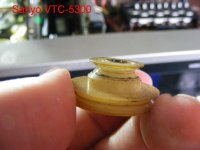 117-diyaudio.jpg130.1 KB · Views: 189
117-diyaudio.jpg130.1 KB · Views: 189 -
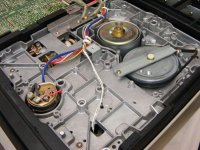 124-diyaudio.jpg650.9 KB · Views: 91
124-diyaudio.jpg650.9 KB · Views: 91 -
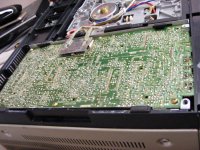 123-diyaudio.jpg783.3 KB · Views: 96
123-diyaudio.jpg783.3 KB · Views: 96 -
 122-diyaudio.jpg777.2 KB · Views: 92
122-diyaudio.jpg777.2 KB · Views: 92 -
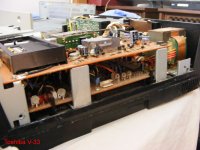 121-diyaudio.jpg524.1 KB · Views: 151
121-diyaudio.jpg524.1 KB · Views: 151 -
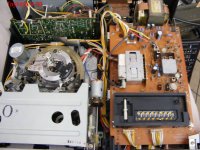 120-diyaudio.jpg667 KB · Views: 141
120-diyaudio.jpg667 KB · Views: 141 -
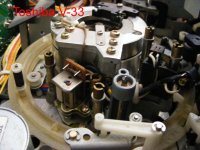 119-diyaudio.jpg169.5 KB · Views: 155
119-diyaudio.jpg169.5 KB · Views: 155 -
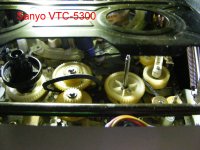 118-diyaudio.jpg189.1 KB · Views: 158
118-diyaudio.jpg189.1 KB · Views: 158
Last edited:
Dan ( Max ) I know to never use toilet tissue on a video head. Dabbing helped I think. I no no I did fully knowing. Sony used chamois leather lolly sticks. They looked brutal. Isoproponol was used
******* hell. Things just keep on getting worse as time goes on don't they?
The mint condition Sanyo VTC-M20 has arrived with the front of the VCR all smashed up to hell like it was beaten to death with a ******* mallet. 😡
Needless to say there is no damage to the box that the VCR was shipped in and so therefore I am fuming like a god damn volcano right now.
EDIT: I found some damage inside of the box due to an impact. So the seller and the courier is to blame.
The mint condition Sanyo VTC-M20 has arrived with the front of the VCR all smashed up to hell like it was beaten to death with a ******* mallet. 😡
Needless to say there is no damage to the box that the VCR was shipped in and so therefore I am fuming like a god damn volcano right now.
EDIT: I found some damage inside of the box due to an impact. So the seller and the courier is to blame.
Attachments
Last edited:
If there wasn't 2 inches of suitable packing with boxes all the companies would do is give a lecture. I recently drove prototypes to head office because I thought there wasn't a chance of safe delivery. That passes the responsibility to others. They know the score and do more packing than me. If pickup arms can be removed it's best.
Normally you don't. 🙂 I suppose if the edges of the tape are in the frame lines it would be invisible, but usually you can see the tape edges as they go by.That's all I ever used. How do you do an invisible splice for film with tape?
- Status
- Not open for further replies.
- Home
- Member Areas
- The Lounge
- Why?
